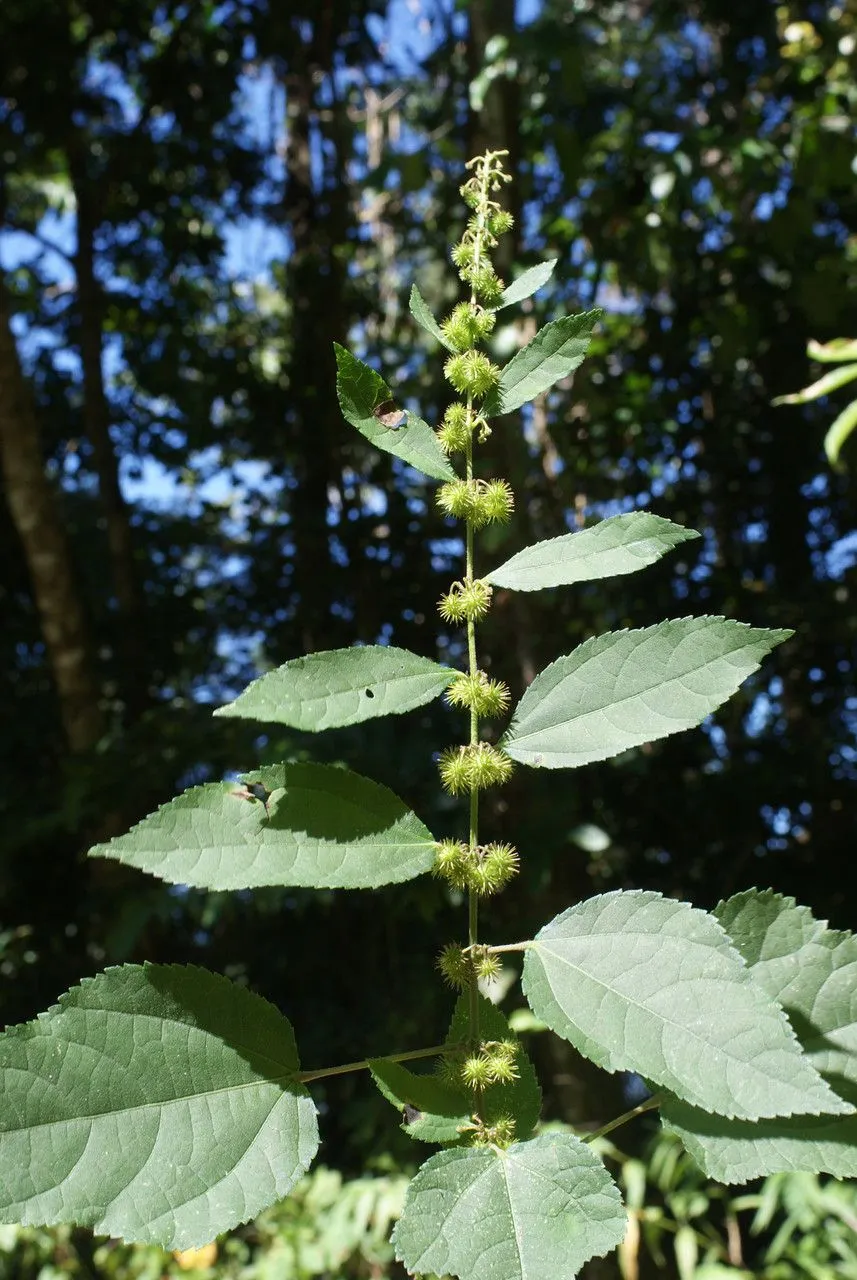
Author: Jacq.
Bibliography: Enum. Syst. Pl.: 22 (1760)
Year: 1760
Status: accepted
Rank: species
Genus: Triumfetta
Vegetable: False
Observations: Trop. & Subtrop. Old World
Chinese-bur: An In-depth Look at Triumfetta rhomboidea
Triumfetta rhomboidea, commonly known as Chinese-bur, is a fascinating plant species that is recognized for its robust adaptability and broad presence across tropical and subtropical regions of the Old World. Named and described by the botanical author Jacquin in his seminal work, “Enumeratio Systematica Plantarum” in 1760, this plant has intrigued botanists and horticulturists alike for centuries.
Belonging to the Malvaceae family, Chinese-bur is distinguished by its unique botanical characteristics. The plant typically features rhomboid-shaped leaves, which is indicative of its species name ‘rhomboidea’. These leaves are one of the identifying hallmarks, showcasing a simple yet elegant leaf morphology that complements the plant’s overall aesthetic.
In its natural habitat, Triumfetta rhomboidea thrives in a range of ecosystems across the tropics and subtropics, effectively illustrating its versatility and resilience. It has adapted to diverse environmental conditions, enabling it to grow in various soils and climates. Such adaptability makes it a valuable study subject for understanding plant resilience and ecological interactions in different settings.
The plant is also notable for its uses in traditional medicine and other practical applications in some cultures. Various parts of the Chinese-bur are utilized for their potential therapeutic properties, attributed to the bioactive compounds they contain. These traditional practices underscore the plant’s significance beyond its botanical interest, highlighting its role in the cultural and medicinal practices of communities within its growing regions.
Moreover, Triumfetta rhomboidea plays a role in local ecosystems. Its growth patterns and interactions with other flora and fauna contribute to the biodiversity and ecological balance within its natural habitats. This makes the plant not only an object of scientific interest but also an integral part of maintaining the health and stability of its native environments.
In conclusion, Chinese-bur, or Triumfetta rhomboidea, is an intriguing species within the Malvaceae family. Its widespread presence in the tropical and subtropical Old World, combined with its unique botanical features and practical uses, make it a plant of significant interest both scientifically and culturally. By understanding its characteristics and ecological roles, we gain insights into the broader tapestry of plant life and its interaction with human societies.
Eng: chinese burr, chinese-bur, chineseshrub, diamond burbark, burr bush, diamond burrbark, paroquet bur, paroquet-bur
Por: carrapicho-grande, malva-preta
Swa: kamuchokochea
Kon: kilindila kinseke, makambula
Kin: kishokongoro, muhigura, rutetele, tchomia, umucundura, umushigura, umushyigura
Lub: lunkole kiloko
Run: matole
En: Chinese-bur, Chineseshrub, Paroquet-bur, Diamond burbark, Triumfetta, Diamond Burrbark, Chinese burr, Burr bush, Paroquet bur, Wild Maho, African burrbark, Burweed, Common Burbush
Bn: বন ওকরা
Zh: Ci shuo ma, 刺蒴麻
Fr: Larisson
Rw: Kishokongoro, Muhigura, Rutetele, Tchomia, Umucundura, Umushigura, Umushyigura
Rn: Matole, Umuvumvu, Umuzirikadama [umuzirikantama]
Kg: Kilindila kinseke, Makambula
Lu: Lunkole kiloko
Ml: ഊർപ്പം
Pt: Carrapicho-grande, Malva-preta
Sw: Kamuchokochea
Zh-tw: 刺蒴麻
Taken Aug 14, 2021 by Flor Alex (cc-by-sa)
Taken Feb 22, 2017 by Tela Botanica − Liliane ROUBAUDI (cc-by-sa)
Taken Aug 20, 2017 by Tela Botanica − Anziz AHMED ABDOU (cc-by-sa)
Taken Aug 20, 2017 by Tela Botanica − Anziz AHMED ABDOU (cc-by-sa)
Taken Aug 20, 2017 by Tela Botanica − Anziz AHMED ABDOU (cc-by-sa)
© copyright of the Board of Trustees of the Royal Botanic Gardens, Kew.
© copyright of the Board of Trustees of the Royal Botanic Gardens, Kew.
© copyright of the Board of Trustees of the Royal Botanic Gardens, Kew.
Taken Nov 26, 2004 by Royal Botanic Garden Edinburgh – Anthony G. Miller (cc-by-nc)
Taken Feb 22, 2017 by Tela Botanica − Liliane ROUBAUDI (cc-by-sa)
Taken Feb 22, 2017 by Tela Botanica − Liliane ROUBAUDI (cc-by-sa)
Taken Feb 22, 2017 by Tela Botanica − Liliane ROUBAUDI (cc-by-sa)
Taken Dec 29, 2019 by Dr Ashwathanarayana Rao (cc-by-sa)
Taken Jan 1, 1900 by EOL − Bart Wursten (cc-by-nc)
Taken Aug 20, 2017 by Tela Botanica − Anziz AHMED ABDOU (cc-by-sa)
Taken Aug 20, 2017 by Tela Botanica − Anziz AHMED ABDOU (cc-by-sa)
Taken Aug 20, 2017 by Tela Botanica − Anziz AHMED ABDOU (cc-by-sa)
Taken Jun 3, 2021 by Arno D’Arcangelo (cc-by-sa)
Taken Nov 22, 2004 by Royal Botanic Garden Edinburgh – Anonymous (cc-by-nc)
Taken Feb 22, 2017 by Tela Botanica − Liliane ROUBAUDI (cc-by-sa)
Taken Feb 22, 2017 by Tela Botanica − Liliane ROUBAUDI (cc-by-sa)
Taken Feb 22, 2017 by Tela Botanica − Liliane ROUBAUDI (cc-by-sa)
Taken Aug 20, 2017 by Tela Botanica − Anziz AHMED ABDOU (cc-by-sa)
Taken Nov 26, 2004 by Royal Botanic Garden Edinburgh – Anthony G. Miller (cc-by-nc)
Growth habit: Subshrub, Shrub
Family: Myrtaceae Author: (F.Muell.) K.D.Hill & L.A.S.Johnson Bibliography: Telopea 6: 402 (1995) Year: 1995 Status:…
Family: Rubiaceae Author: Pierre ex A.Froehner Bibliography: Notizbl. Bot. Gart. Berlin-Dahlem 1: 237 (1897) Year:…
Family: Sapindaceae Author: Koidz. Bibliography: J. Coll. Sci. Imp. Univ. Tokyo 32(1): 38 (1911) Year:…
Family: Asteraceae Author: A.Gray Bibliography: Pacif. Railr. Rep.: 107 (1857) Year: 1857 Status: accepted Rank:…
Family: Fabaceae Author: Medik. Bibliography: Vorles. Churpfälz. Phys.-Ökon. Ges. 2: 398 (1787) Year: 1787 Status:…
Family: Aspleniaceae Author: (Cav.) Alston Bibliography: Bull. Misc. Inform. Kew 1932: 309 (1932) Year: 1932…